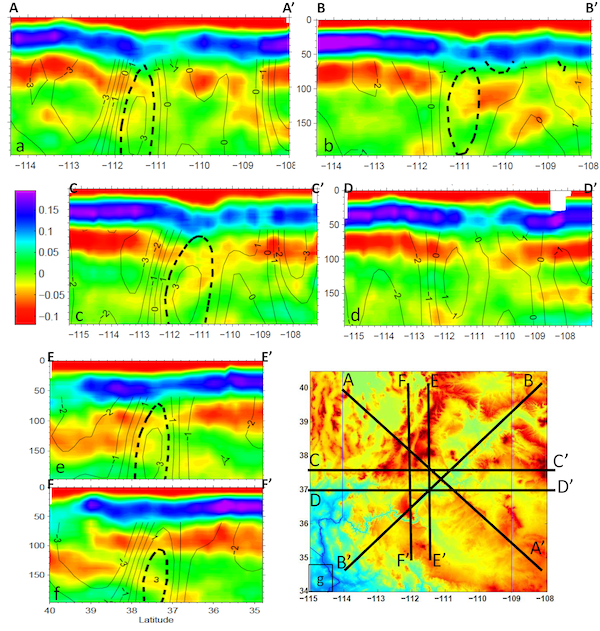2012 IRIS Workshop
Sp imaging of the Escalante Anomaly in Southern Utah
Katie Foster:University of Wyoming, Ken Dueker:University of Wyoming, Steve Hansen:University of Wyoming, Brandon Schmandt:CalTech
Sp image volume and P-velocity contour overlay (Schmandt and Humphreys, 2010). (g) Topography and cross sections. (a-f) Sp sections with P-velocity contour overlays. The two percent fast contour (dotted line) outlines the Escalante Anomaly.

Full-resolution graphics file in original format: 0103.jpg
A multi-channel (1200 channels) deconvolution (Hansen and Dueker, 2010) has produced a coherent Sp image volume from EarthScope/RISTRA data. Beneath the SW Colorado Plateau, P/S velocity tomograms find a high velocity body extending to 190 km depth beneath Escalante, Utah (Schmandt and Humphreys, 2010) we term the Escalante Anomaly (EA). Previous Ps/Sp images were interpreted to define a positive polarity arrival dipping to the NE that is interpreted as manifesting a delamination event that nucleated to the NE beneath the Plateau core (Levander et al., 2011; Reid et al., 2012). Our Sp sections find that the dominate 80-100 km depth NPA disappears above the EA with a deeper intermittent NPA signal dipping towards the west and south (Fig. c-f). Beneath the core of the Plateau, we interpret the 80-100 km NPA as a mid-lithospheric arrival that manifests a <1100° C metasomatic layer contain low velocity minerals (see McClenahan et al., this volume) . This interpretation is consistent with a 140 km thick lithosphere recorded by xenoliths from the 30-20 Ma Navajo Volcanic Field (Smith, 2011) and the generation of the Navajo serpentenized ultra-mafic minette volcanics via melting of metasomatised peridotite at 140 km depth (Smith, 2010). The shallower NPA within the Basin and Range province likely maps the movement of magma and heat upwards into the base of the thermal lithosphere. Given the olivine melt inclusion P/T/H20 measurements from late Quaternary volcanic tephra in SW Utah and the Grand Canyon (T. Plank, pers. com.), the NPA in these low velocity regions is interpreted as a LAB type arrival.
For further reading: Hansen, S. and Dueker, K., P- and S-wave Receiver Function Image of Crustal Imbrication beneath the Cheyenne Belt in SE Wyoming, Bull. Seism. Soc. Am., 2009. Levander, A., B. Schmandt, et al., Continuing Colorado plateau uplift by delamination-style convective lithospheric downwelling, Nature, 2011. Reid, M et al., Melting under the Colorado Plateau, USA, Geology, 2012. Smith, D. et al., Inclusions within Diatremes on the Colorado Plateau, SWUSA: Implications for the Mantle Wedge during Low-angle Subduction, J. Petrol., 2010.
Keywords: sp_receiver_function, ccp_imaging, velocity_anomaly, escalante
